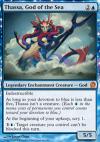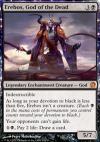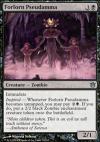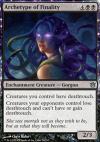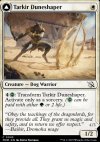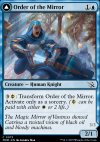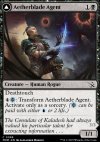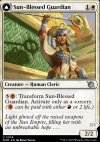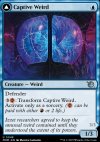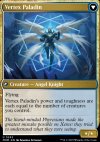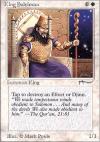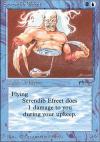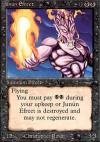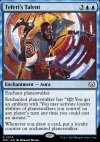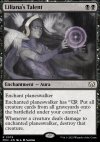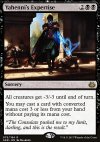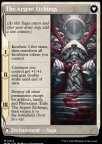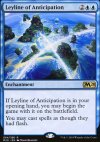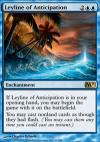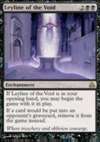|

Archive des News/Articles |
Forum Gazette |
Artgame |
MWS |
MV wiki |
Contact |
Storyline
MAJ Aux portes des Éternités (04/07)
|
Anecdotes
Général |
OIK |
Échanges |
Règles |
Tournois |
Rumeurs |
Decks |
Vintage |
Legacy |
Modern |
Pioneer |
Standard |
Peasant |
Commander |
Tiny Leaders |
Explorer |
MTG Arena

MV anecdotes
| 952 anecdotes trouvées |   |
Les cinq cartes Heliod, God of the Sun, Thassa, God of the Sea, Erebos, God of the Dead, Purphoros, God of the Forge et Nylea, God of the Hunt, de l'édition Theros, forment un cycle de dieux.
Les cinq cartes God-Favored General, Aerie Worshippers, Forlorn Pseudamma, Satyr Nyx-Smith et Pheres-Band Raiders, de l'édition Born of the Gods, forment un cycle.
Les cinq cartes Archetype of Courage, Archetype of Imagination, Archetype of Finality, Archetype of Aggression et Archetype of Endurance, de l'édition Born of the Gods, forment un cycle appelé "Archetype".
Les cinq cartes Heaven's Gate, Sea Kings' Blessing, Touch of Darkness, Dwarven Song et Sylvan Paradise, de l'édition Legends, forment un cycle.
Les cinq cartes Glyph of Life, Glyph of Delusion, Glyph of Doom, Glyph of Destruction et Glyph of Reincarnation, de l'édition Legends et illustrées par Susan Van Camp, forment un cycle appelé "Glyph".
Les cinq cartes Karakas, Tolaria, Urborg, Hammerheim et Pendelhaven, de l'édition Legends, forment un cycle de terrains.
Les cinq cartes Cathedral of Serra, Seafarer's Quay, Unholy Citadel, Mountain Stronghold et Adventurers' Guildhouse, de l'édition Legends, forment un cycle de terrains.
Les cinq cartes Alabaster Host Intercessor, Tidal Terror, Gloomfang Mauler, Furnace Host Charger et Timberland Ancient, de l'édition March of the Machine, forment un cycle de créatures avec la capacité Recyclage d'un terrain de base.
Les cinq cartes Tarkir Duneshaper, Order of the Mirror, Aetherblade Agent, Pyretic Prankster et Bonded Herdbeast, de l'édition March of the Machine, forment un cycle de créatures pouvant chacune se transformer en Phyrexian avec une couleur alliée.
Les dix cartes Seraph of New Capenna, Sun-Blessed Guardian, Captive Weird, Skyclave Aerialist, Blightreaper Thallid, Nezumi Freewheeler, Harried Artisan, Khenra Spellspear, Gnottvold Hermit et Herbology Instructor, de l'édition March of the Machine, forment un cycle de créatures peu communes pouvant chacune se transformer en Phyrexian avec une couleur ennemie.
Source 1 (Double-Faced Cards That Become Phyrexian) - Source 2 (Transforming double-faced cards (TDFCs) of normal creatures becoming Phyrexian with a Phyrexian mana activation for the change)
Source 1 (Double-Faced Cards That Become Phyrexian) - Source 2 (Transforming double-faced cards (TDFCs) of normal creatures becoming Phyrexian with a Phyrexian mana activation for the change)
Les dix cartes Invasion of Xerex, Invasion of Amonkhet, Invasion of Azgol, Invasion of Ergamon, Invasion of Moag, Invasion of New Capenna, Invasion of Kaladesh, Invasion of Lorwyn, Invasion of Kylem et Invasion of Pyrulea, de l'édition March of the Machine, forment un cycle de batailles bicolores peu communes soutenant chacune un archétype de formats limités, en complément du traditionnel cycle de sorts bicolores peu communs (voir cette anecdote).
Les dix cartes Marshal of Zhalfir, Halo Forager, Stormclaw Rager, Rampaging Geoderm, Botanical Brawler, Sculpted Perfection, Joyful Stormsculptor, Elvish Vatkeeper, Mirror-Shield Hoplite et Mutagen Connoisseur, de l'édition March of the Machine, forment un cycle de permanents bicolores peu communs soutenant chacun un archétype de formats limités.
Source 1 (A Well-Oiled Machine) - Source 2 ("Draft, as an example, had a big influence on the uncommon gold cards that model Draft archetypes")
Source 1 (A Well-Oiled Machine) - Source 2 ("Draft, as an example, had a big influence on the uncommon gold cards that model Draft archetypes")
Citation :
Now that we've gotten through the mechanics, I want to end today's column by briefly going through the draft archetypes.
White-Blue (Knights) – This archetype is one of two that has a creature-type component. This is a combat focused deck that makes use of the Knight creature type.
Blue-Black (Graveyard) – This deck mills everyone and then takes advantage of graveyards being filled.
Black-Red (Sacrifice) – This controlling deck creates resources that it then sacrifices, especially artifacts.
Red-Green (Battles) – This archetype takes advantage of the new battle cards, including cards that aid you in interacting with them.
Green-White (+1/+1 Counters) – This is a go-wide archetype that makes use of +1/+1 counters to build up your army.
White-Black (Phyrexians) – This is the archetype that mechanically cares about the Phyrexian creature type and makes a lot of use of incubate.
Blue-Red (Convoke) – This archetype has the most convoke spells and makes use of its creatures to cast a lot of them.
Black-Green (Incubate) – This archetype is about playing bigger creatures and makes use of larger incubate tokens.
Red-White (Backup) – This archetype makes the most use of the new backup mechanic, allowing your creatures to team up and take out the Phyrexians.
Green-Blue (Transformation) – This archetype takes advantage of all the TDFCs in the set (including Phyrexian TDFCs, incubate, and battles) and mechanically rewards you for transforming.
White-Blue (Knights) – This archetype is one of two that has a creature-type component. This is a combat focused deck that makes use of the Knight creature type.
Blue-Black (Graveyard) – This deck mills everyone and then takes advantage of graveyards being filled.
Black-Red (Sacrifice) – This controlling deck creates resources that it then sacrifices, especially artifacts.
Red-Green (Battles) – This archetype takes advantage of the new battle cards, including cards that aid you in interacting with them.
Green-White (+1/+1 Counters) – This is a go-wide archetype that makes use of +1/+1 counters to build up your army.
White-Black (Phyrexians) – This is the archetype that mechanically cares about the Phyrexian creature type and makes a lot of use of incubate.
Blue-Red (Convoke) – This archetype has the most convoke spells and makes use of its creatures to cast a lot of them.
Black-Green (Incubate) – This archetype is about playing bigger creatures and makes use of larger incubate tokens.
Red-White (Backup) – This archetype makes the most use of the new backup mechanic, allowing your creatures to team up and take out the Phyrexians.
Green-Blue (Transformation) – This archetype takes advantage of all the TDFCs in the set (including Phyrexian TDFCs, incubate, and battles) and mechanically rewards you for transforming.
Dans l'édition Arabian Nights, la couleur blanche est la seule qui ne contient aucune créature de type Éfrit ou Djinn, alors que les autres couleurs en contenaient au moins une de chaque type.
À cette époque, la couleur blanche se voulait contrôler les autres couleurs (Circle of Protection (voir cette anecdote), Ward (voir cette anecdote) : ainsi fut créée la carte King Suleiman et sa capacité à détruire ces types de créature.
Les quatre Éfrits de l'édition :
• Serendib Efreet
• Junún Efreet
• Ydwen Efreet
• Ifh-Bíff Efreet
Les quatre Djinns de l'édition :
• Serendib Djinn
• Juzám Djinn
• Mijae Djinn
• Erhnam Djinn
À cette époque, la couleur blanche se voulait contrôler les autres couleurs (Circle of Protection (voir cette anecdote), Ward (voir cette anecdote) : ainsi fut créée la carte King Suleiman et sa capacité à détruire ces types de créature.
Les quatre Éfrits de l'édition :
• Serendib Efreet
• Junún Efreet
• Ydwen Efreet
• Ifh-Bíff Efreet
Les quatre Djinns de l'édition :
• Serendib Djinn
• Juzám Djinn
• Mijae Djinn
• Erhnam Djinn
Les cinq cartes Path of the Ghosthunter, Path of the Enigma, Path of the Schemer, Path of the Pyromancer et Path of the Animist, de l'édition March of the Machine Commander Decks, forment un cycle appelé "Path".
Chacune fait référence à un planeswalker de par son nom et son illustration, respectivement Kaya, Geist Hunter, Kasmina, Enigma Sage, Tezzeret the Schemer, Chandra, Pyromaster et Nissa, Sage Animist.
Chacune fait référence à un planeswalker de par son nom et son illustration, respectivement Kaya, Geist Hunter, Kasmina, Enigma Sage, Tezzeret the Schemer, Chandra, Pyromaster et Nissa, Sage Animist.
Les cinq cartes Elspeth's Talent, Teferi's Talent, Liliana's Talent, Rowan's Talent et Vivien's Talent, de l'édition March of the Machine Commander Decks, forment un cycle appelé "Talent".
Les dix cartes Spire Patrol, Tezzeret's Touch, Weldfast Engineer, Outland Boar, Renegade Rallier, Hidden Stockpile, Maverick Thopterist, Winding Constrictor, Renegade Wheelsmith et Rogue Refiner, de l'édition Aether Revolt, forment un cycle de permanents bicolores peu communs soutenant chacun un archétype de formats limités.
Source ("Draft, as an example, had a big influence on the uncommon gold cards that model Draft archetypes")
Source ("Draft, as an example, had a big influence on the uncommon gold cards that model Draft archetypes")
Les cinq cartes Implement of Improvement, Implement of Examination, Implement of Malice, Implement of Combustion et Implement of Ferocity, de l'édition Aether Revolt, forment un cycle appelé "Implement".
Les cinq cartes Aegis Automaton, Watchful Automaton, Augmenting Automaton, Welder Automaton et Verdant Automaton, de l'édition Aether Revolt, forment un cycle appelé "Automaton".
Source (The Automaton Cycle)
Source (The Automaton Cycle)
Les cinq cartes Sram's Expertise, Baral's Expertise, Yahenni's Expertise, Kari Zev's Expertise et Rishkar's Expertise, de l'édition Aether Revolt, forment un cycle appelé "Expertise".
Les cinq cartes Elesh Norn, Jin-Gitaxias, Sheoldred, Urabrask et Vorinclex, de l'édition March of the Machine, forment un cycle des Praetors Phyrexians pouvant chacun se transformer en saga avant de revenir ensuite à son état initial de créature.
Source 1 (Praetors) - Source 2 ("Set Design chose to use the Praetors that transformed into Sagas.") - Source 3 (Different takes for a cycle of Phyrexian Praetors)
Source 1 (Praetors) - Source 2 ("Set Design chose to use the Praetors that transformed into Sagas.") - Source 3 (Different takes for a cycle of Phyrexian Praetors)
Les cinq cartes Leyline of Sanctity, Leyline of Anticipation, Leyline of the Void, Leyline of Combustion et Leyline of Abundance, de l'édition Core Set 2020 et illustrées par Noah Bradley, forment un cycle de Leylines.
Source (Rare Cycles - Leylines)
Source (Rare Cycles - Leylines)
Les cinq cartes Leyline of Sanctity, Leyline of Anticipation, Leyline of the Void, Leyline of Punishment et Leyline of Vitality, de l'édition Magic 2011, forment un cycle de Leylines.
Les cinq cartes Leyline of the Meek, Leyline of Singularity, Leyline of the Void, Leyline of Lightning et Leyline of Lifeforce, de l'édition Guildpact, forment un cycle de Leylines. De plus leurs textes d'ambiance se font écho.
| 952 anecdotes trouvées |   |





 Tarkir: Dragonstorm
Tarkir: Dragonstorm Aetherdrift
Aetherdrift Foundations
Foundations Duskmourn
Duskmourn Bloomburrow
Bloomburrow Modern Horizons III
Modern Horizons III Outlaws of Thunder Junction
Outlaws of Thunder Junction
